Yesterday Adobe announced the release of their Digital Editions software. The software’s been available in a beta format for a while; I downloaded it back then & didn’t think it was interesting enough to write about. I’ve spent the past two days playing with the new release. I’m still not sure that it’s worth attention, but I’ll try to explain why it’s not interesting.
What is Digital Editions? It’s still a bit hard to tell. When I downloaded the beta version, it seemed to be a lightweight remake of Adobe Reader (née Acrobat Reader), Adobe’s PDF viewer. The full release expands the capabilities of Digital Editions: in addition to being a PDF viewer, it’s also a viewer for the new EPUB format. It also seems to be a front end for future web-based electronic book sellers, like Apple’s iTunes for music. I’ll go through each of these three uses in turn, but first a few notes on how Digital Editions works.
Digital Editions looks more like a web application than a desktop application. There are no menu bars to speak of, and its interface borrows nothing from the operating system. This is nice in that it feels like it’s a reading environment: the interface is black-on-black, which should block out the distractions rampant on the desktop. Certainly there’s none of the excess frippery that comes with Acrobat. However, the minimalism may be a bit excessive: it can be difficult to find black buttons and sliders to turn pages. (I’d be curious to see a review of the application from someone interested in accessibility for the disabled.) And some controls don’t behave the way a user might expect: given a scrollbar along the right edge of a page, I expect to be able to click at a point where the slider isn’t to move the slider. No such luck. Nor can you drag-select to change which part of the page is visible when the page is larger than the window, or drag a file into the window to open it.
Many of my problems with it stem from it not behaving like Mac software; I suspect a PC user would have similar complaints about it not behaving like PC software. This wouldn’t matter if the interface were an improvement over the operating systems – in both there’s plenty of room for improvement – but it’s not a noticeable improvement. It’s simply different, and that slows users down.
1. as a PDF reader
As mentioned above, Digital Editions initially seemed to be a remake of Adobe Reader, which has become hideously bloated with time. The current OS X version of the software is 108Mb; it’s a slow program. While I look at a fair number of PDFs on a daily basis, I’ve long since stopped using Acrobat in any of its forms if I don’t have to; Apple’s Preview application is much faster and delivers almost all the functionality that I want out of a PDF reader. I suspect most other Mac users do the same. Acrobat can be useful if you’re doing print pre-press work or working with forms, but neither of those are things I do that often.
Digital Editions does work as a PDF viewer. It’s based around a library concept, so every time you open a PDF in DE, an image of the front page is saved in the library; you can click on this image to open it. Once you have a PDF, you can look at it as a single page, as a double page (even if the PDF hasn’t been set up for this), at the width of the screen, or with a zoom widget that lets you use 18 levels of zoom from 87% to 919%. Here’s how a PDF from /ubu editions looks:
Digital Editions is clearly built around a different PDF rendering engine than the rest of Adobe’s software. (The FAQ explains that this engine was designed to be used on cellphones.) Image quality is noticeably worse than in Acrobat or Preview. Text is poorly aliased, and spacing between characters seems to be off for some fonts at some zoom levels. Graphics are notably grainy, and weird rendering artifacts sometimes show up. (In the image above, for example, note that there’s a light blue rectangle under the text on the left. This doesn’t show up in any other PDF viewer.) Some PDFs have extras that shouldn’t have been there, blocks of background color, for example. One illustration of the color picker in the Sophie help PDF I made a couple weeks back turns a lovely shade of purple:
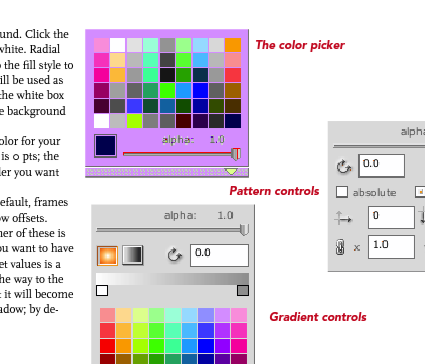
This is frustrating: one of Adobe’s chief selling points of PDF as a format has been that a PDF will look the same on every machine in every viewer. Not this one. Adobe offers sample PDFs for download at their Digital Editions website (see below), which are similarly perplexing. Although these appear to be ordinary PDFs (with no restrictions), they don’t behave like regular PDFs. They can’t be opened in any PDF viewer that’s not Digital Editions. Preview shows only blank pages; opening them in the current Adobe Reader takes you to a webpage where you can download Digital Editions; and opening them in an older version of Acrobat brings up a message asking whether I’d like to learn more about documents protected with Adobe DRM. Clicking yes takes me to a pre-Digital Editions Adobe ebooks page. PDFs have become popular because they can be used in a variety of ways across a variety of platforms. This seems like a significant step backwards for Adobe: interoperability is taking a back seat to DRM.
2. as an EPUB reader
But Digital Editions isn’t only a PDF viewer; it’s also a viewer for EPUB format. EPUB is the work of the IDPF; it’s essentially an XHTML format for ebooks. You can get sample EPUBs from Adobe’s website. If you have the latest version of Adobe InDesign, you can make them yourself (more about that in a bit). Here’s the front page of their edition of Alice’s Adventures in Wonderland:
Perhaps not surprisingly for an XHTML format, the experience of reading an EPUB in Digital Editions is similar to reading a web page. The text becomes as wide as the Digital Editions window; if the window is wide enough, the text may reflow into more columns. When this happens is unclear to me: in some books, the text column is much too wide to read well before the text is reflowed:
You can choose between 4 different font sizes; you can’t change the fonts. (Some EPUB books include their own fonts; some use system fonts.) As in the Digital Editions PDF viewer, there’s some bookmarking capability: you can select text and click “Add bookmark” to add a note at a particular point in the text. Books have tables of contents; there’s a search function. You can print books (or, on a Mac, convert them to PDFs); this seems to be in two columns by default.
That seems to be all you can do with these books. The books that Adobe provides are noticeably ugly: most of the graphics included are low resolution. Text looks weirdly bad: in the default font, the italic text seems to actually be slanted roman characters, which you’d think Adobe would be embarrassed about. To my eye, the text looks much better in Safari or even Firefox. You can make this comparison if you rename the .epub file .zip and unzip it; in the resulting folder, you’ll find a bunch of HTML pages, the images used, and fonts, if they’re included.
Adobe trumpets the one-click creation of EPUB files in the new version of InDesign. So I fired up InDesign and made some EPUBs to see how those worked in Digital Editions. Try for yourself: here is a version of the Sophie help PDF in EPUB format. The results are a bit disappointing: all the graphics have been dumped at the end of the document, much of the formatting has been lost, and the table of contents I laboriously set up for PDF export has been eliminated. One-click conversion evidently doesn’t allow exporting the fonts the document uses; and even though I have the Avenir and Scala fonts on my machine, it displays in the default Digital Editions font. The graphics do display in their real color, which is more than you can say for the way Digital Editions handles the PDF, though many of them do seem to have been converted to JPEGs in a lossy way.
As a whim, I fed InDesign’s converter some foreign-language poetry to see how it would handle Unicode text. French came through okay. Lithuanian was mangled beyond recognition. Some Chinese poetry didn’t work at all:
It’s clear that this needs a lot of work before it can be taken seriously.
3. as a store
From Adobe’s press release, it’s clear that the main impetus behind Digital Editions is to provide a local front end for web-based selling of ebooks. The model that Adobe is working on becomes apparent when you open it up: the program maintains a library of all the PDF files you look at, in the same way that iTunes maintains a library of the MP3s on your computer:
Categories of books (on the left in the above screenshot) include “Borrowed” and “Purchased”. The iTunes model of incorporating a store in software isn’t necessarily a bad one: Linotype has embedded a font store in their free font management software, with some degree of success. It’s hard to tell how well Adobe’s integration will work. They’ve tried selling ebooks before with little success; I have a couple of PDFs bought from Amazon that I’ve long since despaired of ever opening again. (Some progress may be reported: clicking on these now now opens DigitalEditions, where I get a different cryptic error than I did before in Acrobat.) The same sort of problems are likely with ebooks designed for DigitalEditions; it does worry me that even PDFs without DRM can’t be opened outside of the software.
DRM are probably the logical place to end this overlong review. One of the major reasons that we haven’t spent much time covering the efforts of the IDPF is that it’s devoted to standards that satisfy producers rather than consumers; many producers are concerned with locking down their products as thoroughly as possible. It may be a reasonable position from their perspective, but it’s resulted in products that aren’t particularly useful to consumers. DigitalEditions looks like it might be a big piece in the puzzle for DRM-focused producers. Unfortunately, readers are being neglected.


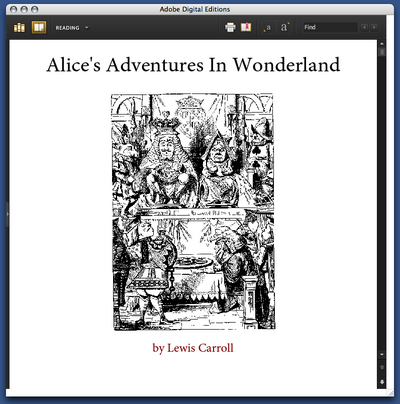
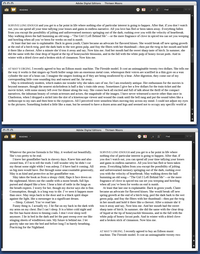
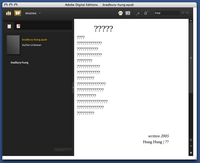
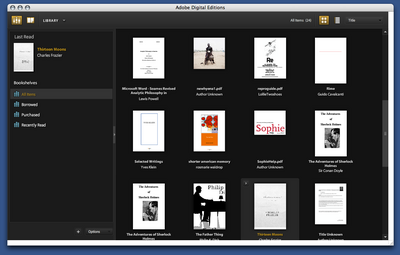
dan said:
> One of the major reasons that we haven’t spent
> much time covering the efforts of the IDPF is that
> it’s devoted to standards that satisfy producers
> rather than consumers; many producers are concerned
> with locking down their products as thoroughly as possible.
amen.
but it’s even worse than that.
the publishers _as_an_industry_ are attempting to
raise the cost of entry into their business.
in a nutshell, the ability for _anyone_ to use the web
to become a publisher at virtually no up-front cost
scares the dickens out of this greedy industry…
so they’re now trying to make publishing _complex_,
and what better way than to make the format complex?
people _will_ flock to the web as a publishing machine
_if_ the process is sufficiently simple. remember that
when it was easy to “view source” on a webpage and
learn how to make it work, personal pages _exploded_…
likewise, look how simple blogging software released
a _storm_ of people expressing themselves…
so the publishing industry would very much like to
throw the wrench of complexity into that machine…
and adobe is willing to do all their dirty work for them
(just so long as it can make enough sales of indesign).
but the genie has been unleashed. people won’t give up
simplicity, not even to get into the biggest web-based
e-book stores. no, we will just create our own stores…
and thus distribution will become as easy as production.
furthermore, we will fill the gatekeeper/slush-pile role
by using _collaborative_filtering_. and this means that
once we have a tool that helps ensure good copy-editing,
we’ll have eliminated every reason for the old publishers.
the publishing industry did a pretty good job of things
— up until the last 20 years or so, anyway, when it was
merged into general corporate ops and made to answer
to accountants with no sense of the vital mission within —
but they now need to be retired (with their yachts and
their secret numbered bank-accounts) to the bahamas.
because if they _insist_ in their efforts to rip us off,
we’ll put ’em in prison instead. it’s your choice, guys.
-bowerbird
Dan,
Not sure if you picked up the InDesign CS3 update that adds improved TOC support, font embedding, and some other fixes to the EPUB export feature. See:
http://www.adobe.com/support/downloads/detail.jsp?ftpID=3622 . Certainly the IndDesign EPUB support is a work-in-progress but frankly I think that’s understandable given that the EPUB format (aka OPS 2.0) is new, and still in the final stages of standards draft review.
Regarding your Digital Editions comments, I appreciate your perspective and agree that we have a lot of work to do (it is, after all, a 1.0 product). Of course one can’t expect everything in a 3MB download that the much larger Adobe Reader can deliver. But you *can* expect quality levels of images and typography for both PDF & EPUB that are much improved in future versions. We feel that our 1.0 solution already delivers better readability than many competing solutions from other vendors, especially page-image-based “bitmap flippers”.
Clicking on the scrollbar where the slider isn’t doesn’t cause a scroll… yep, a known bug that is annoying and that we plan to fix.
Regarding the IDPF and “standards for producers rather than consumers” – well, I liked your review better when it stuck to fact-based observations. We have authors in the IDPF and we are all consumers. And what is the format that is friendlier to consumers than an open XML format leveraging building-block standards like XHTML and SVG, and why? A pickled Smalltalk VM a la Sophie… uh I don’t think so. BBEdit-like Wiki syntax that is not even standardly usable by geeks across systems much less normal consumers, or some other home-grown idiosyncratic “XML is too hard” format?… nope. The reality is consumers want a graphical experience and as long as the format is open and widely adopted they are happy. Consumers don’t care about angle brackets but they do care about interoperability and XML has become as much a lingua franca as ASCII or Unicode. Consumers don’t even care if a format is technically the best (JPEG was always a markedly inferior image format to alternatives such as FlashPix).
And the fact is that Adobe’s success will depend on making readers happy, more than making publishers happy. At the end of the day our proliferation depends on readers one at a time deciding to user our client software. I think we’ve made a decent start here, and hope you will hang with us and help us improve via feedback like this.
After responding to a reference to this post on Peter Brantley’s (Digital Library Federation) email list, he convinced me to repost here.
A brief note prior to addressing this. I am always highly skeptical of general comments and arguments about digital media being “locked down” without specific examples of how or why this is so. In the case of DRM systems this is correct; it’s the purpose of DRM after all. In the case of .epub it is totally incorrect. Here’s why:
1. .epub is the file extension which applies to two standards, OPS and OCF. OPS (Open Publication Structure) is the markup (either XHTML or DTBook) and navigation (like chapters etc.) of a digital book. OCF (Open Container Format) is a zip file which holds the markup of the book, images, style sheets etc. and has directories in it so publishers can send along metadata and other information about their eBook through distribution. It is simply a means of combining all of these various things that comprise an eBook into one file.
While software can certainly wrap .epub in DRM, there is absolutely nothing in the specs which requires or mandates DRM. In fact, you can download sample .epub files at http://www.idpf.org/forums/viewforum.php?f=5, change the file extension to “.zip”, open the zip file, and have full access to the markup, images etc. of the digital book. We chose ZIP for .epub largely because ZIP applications were so prevalent and…open.
2. Prior to software implementation of .epub, there was no possibility of interoperability between software which had implemented proprietary formats. Now, for example, a consumer can take an unencrypted .epub file and open in it Digital Editions and also open it in eBook Technologies’, Mobipocket’s, Osoft’s etc. software and it should render. This seems like a good thing for consumers.
3. Authoring software is being developed to easily produce .epub files. Adobe InDesign CS3 is an example. The continued creation of authoring tools by conversion houses and other software companies will make it quite a bit easier and cheaper for publishers to produce digital books. This is good for publishers. And, since it will be significantly cheaper to produce digital books, publishers will most likely produce more selection for consumers. This seems good for consumers.
4. From an intellectual property standpoint (which the author doesn’t address), the specs are totally open and free to use. The IDPF does not require you to be a member or pay in any way to use the specs to develop software or produce eBooks. Pretty good for everyone.
There was much compromise in the production of these specifications between publishers, software companies, accessibility advocates etc. and they aren’t perfect. The result for the industry, however, is undoubtedly good. Arguments that they favor producers over customers or are in some way locked down just aren’t correct.
-Nick
—
Nick Bogaty
Executive Director
International Digital Publishing Forum (IDPF)
nbogaty@idpf.org
http://www.idpf.org
Publishers just aren’t going to rush to release unlocked content, just how unfortunate one finds that will vary from person to person, but it’s the reality of the thing. To the extent that IDPF is able to allow producers to standardize around one ‘ebook’ spec, it’s a net gain for consumers, who will be able to get more content and display it on a wider variety of software and hardware platforms. It’s of course the job of the Institute to advocate for new paradigms, but I do think IDPF is doing good pragmatic work–that still might not be able to overcome publishers’ reluctance. Baby steps.
Granted about publishers & DRM. And IDPF and their work certainly demand more scrutiny than I’ve given them here; the review was already getting over-long so I didn’t talk about them as much as I could have, nor about the business strategy they’re presenting, which it’s probably premature to talk about.
I have to say that I’m not really won over by IDPF’s work just because it seems so small-minded: what they’re putting forward doesn’t seem usefully different from HTML so far in just about every way, with the notable exception of DRM support. (It doesn’t help that the first product that uses the standard makes the same content look worse than it does in a web browser.) I just don’t get the sense that anyone’s really looking out for consumer’s rights there.
I feel like there’s a difference between an open format and a usefully open format: Microsoft did ostensibly open the Word format by using XML than a binary, but it’s still a proprietary format in the sense that Microsoft controls the definition of it. My sense is that EPUB is similar. Compare Unicode & the way it’s publicly accountable . . .
(N.B.: Nick Bogaty’s comment got stuck in the spam filter for a bit, which is why subsequent comments don’t address it.)
andrew said:
> Publishers just aren’t going to
> rush to release unlocked content,
> just how unfortunate one finds that
> will vary from person to person,
> but it’s the reality of the thing.
it might be.
but another “reality of the thing”
is that such reluctance is why they
will die just like the dinosaurs…
the infrastructure of the publishers
was designed with scarcity in mind.
the system can only handle a _limited_
number of products, a tiny percentage
of the ones that will soon (very soon)
be available in an “unlocked” state.
the publishing industry used to compete
with itself. but now it’s competing with
every single person with a story to tell.
and most of those people won’t need to
“make a profit” by telling their story.
they just want their story to be heard.
the hand-selected wares of the publishers
will still receive the largest mindshare
— assuming that those publishers still
have their thumb on the customer pulse,
which is increasingly hard to believe,
but i’ll stipulate it for right now —
but the fact of the matter is that they
will only get a _small_slice_ of the pie
that they used to have all to themselves.
even their big advertising budgets won’t
help much (because we’ve become immune to
their hype), and when their business is
shot, they’ll lose those big ad budgets.
why should a person spend good money on a book
that collabortive filtering says she will like,
when she can find five other books for free that
collaborative filtering says she’ll like as well?
have you seen the declining percentage
of the viewing audience that’s captured
by the television _networks_ these days?
it’s a poor imitation of when they ruled,
before cable came in and fragmented us…
the same thing will happen to publishers.
and as they had a hard enough time making
a profit even when they had the whole pie
— or so they kept whining to us, anyway —
let’s see how well they live on a slice…
-bowerbird
(Also Bill McCoy’s comment got stuck in the spam filter! )
I did install the InDesign updater; the results are a little better (there’s one entry in the table of contents rather than no table of contents, one of the font families comes in, though the headers are now bold italic rather than bold) but still not perfect. There’s an error saying that one of the fonts couldn’t be embedded, which I don’t think is because of an embedding bit.
It seems that apart from the tool used to create the epub file, Adobe Digital Editions is unable to show many language characters. I tried editing an epub file to add some Arabic text. It didn’t show up correctly (got only questions marks) even when I specified the text to be in a font that is both installed on my machine and which contains the Arabic letters in Unicode.
Can someone confirm that this is indeed the case, which will be a big disappointment, or if Adobe Digital Editions is supposed to be able to display any unicode text if the fonts are available?
Concering writing in arabic charactes
if you use ARIALUNI.TTF or simpfxo.ttf
they will render arabic glyphs but still it draws it from left to right
it is a matter of render method not font issue.
and so i have one question does Adobe digital Edition Viewer Supports rendering right to left languages?
My guess is no: there’s still no right-to-left support in the CS3 version of InDesign. Maybe InDesign ME would produce EPUB documents?
The important issue is not whether or not InDesign CS3 supports RTL languages (e.g., Arabic, Hebrew, etc.), but the fact that ADE as a reader does not support RTL or bidirectional languages. We can do with no support in InDesign since we can built our own XML tools to create the .epub files, but without being able to read them properly on the reader end, this would be pointless.
I understand that ADE is based on Flash and that Flash 9 does not support RTL but Flash 10 will support RTL (according to Adobe). Can I assume that with version 10, there will be a new version of ADE that supports RTL? If so, what are the time frames?
Thank you for any tips.
I have a complaint of the Digital Editions, It’s not as good as they say. I have been trying for two days to get my e-books downloaded. But every time I try it gives me an error on every single e-book. I even have trouble with the sample books they have on the adobe site and it gives me the same error, I have spend over $100 dollars on e-books and now they won’t even open so I can read them and the people at the adobe site aren’t helping me. I was wondering if anyone has any tips on what I can do.